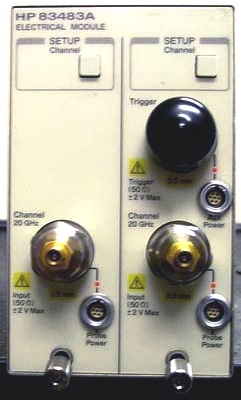
|
|
The Agilent 83483A is a dual electrical channel module plug-in for 83480A and 86100A digital communications analyzer. Has two 20 GHz bandwidth electrical channels with user selectable 12.4 or 20 GHz bandwidths. The lower bandwidth mode provides excellent oscilloscope noise performance for accurate measurement of small signals. The high bandwidth mode provides high-fidelity display and measurement of very high-speed waveforms. 2.5 GHz bandwidth trigger channel. Specifications. Bandwidth: (-3 dB) dc to 12.4 or 20 GHz, user selectable. DC Accuracy - single marker 12.4 GHz bandwidth: ± 0.4% of full scale, ± 2 mV ± 1.5% (reading - channel offset). DC Accuracy - single marker 20 GHz bandwidth: ± 0.4% of full scale, ± 2 mV ± 3% (reading - channel offset). DC Difference - two marker accuracy on same channel 12.4 GHz: ±0.8% of full scale, ±1.5% of delta marker reading. DC Difference - two marker accuracy on same channel 20 GHz: ±0.8% of full scale, ±3% of delta marker reading. Transition Time (10% - 90%) characteristic, calculated from T=0.35/BW, electrical: 28.2 ps (12.4 GHz bandwidth), 17.5 ps (20 GHz bandwidth). RMS Noise Typical: 0.25 mV (12.4 GHz bandwidth), 0.5 mV (20 GHz bandwidth). Scale Factor (full scale is eight divisions): 1 mV/div (minimum), 100 mV/div (maximum). DC Offset Range: ±500 mV. Nominal Input Impedance: 50 ohm. Connectors: 3.5mm (m), channel and trigger. Input Re
ection/Return Loss: <=5% for 30 ps rise time. Number of Channels: 2. Dynamic Range/Maximum Specified Input Power: ±400 mV relative to channel offset. Maximum Safe Input: ±2V + peak ac (+16 dBm).
|